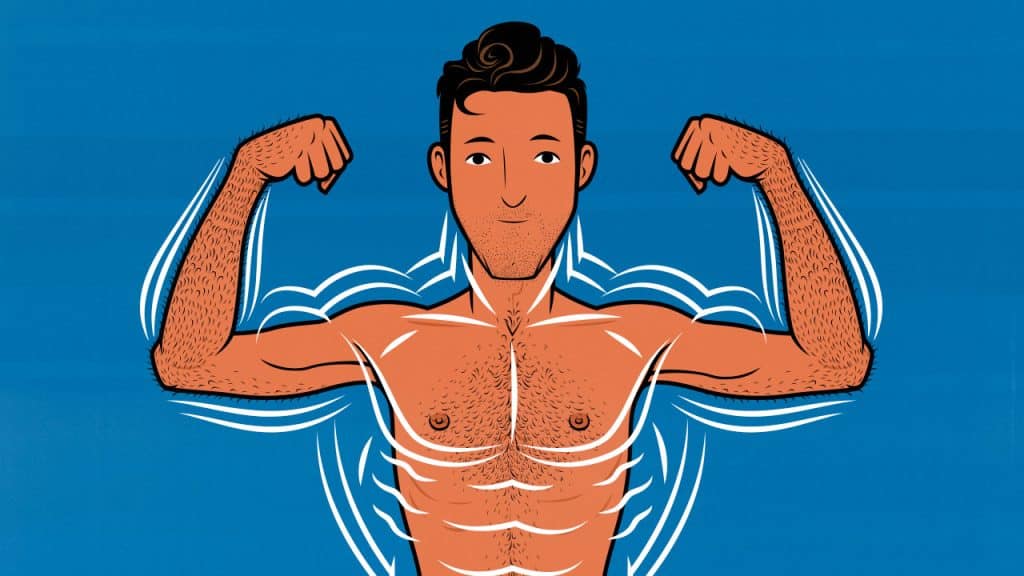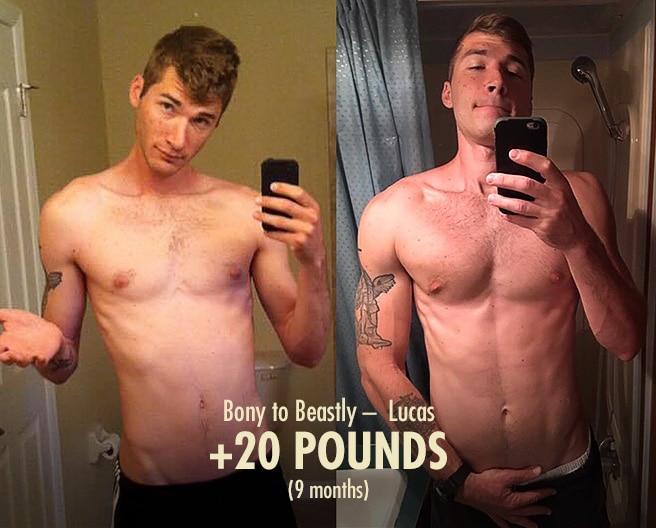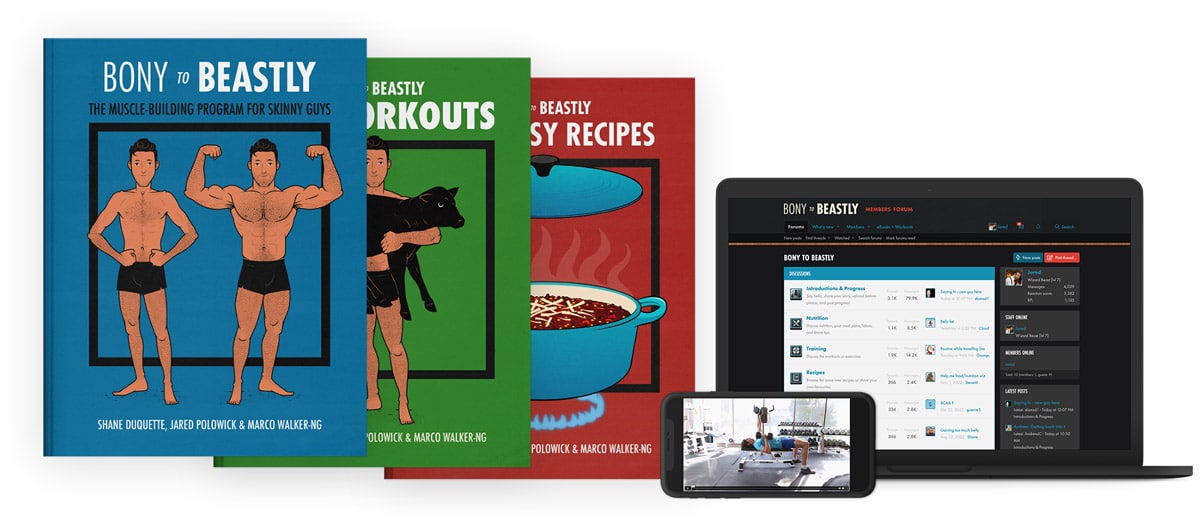
What’s the Best Way to Bulk Up?
There are a few different ways to bulk. You could bulk dirty or cleanly, aggressive or leanly, or anywhere in between. I’ll explain the pros and each so that you can pick the style of bulking that’s best for you.
We’ve been helping people bulk up for over a decade now, with clients ranging from geriatric deskworkers all the way to college, professional, and Olympic athletes. We can help you to do it, too. The results are incredibly consistent.

The Different Types of Bulking Diets
Dirty bulking and clean bulking are two different ways to think about nutrition.
- Dirty bulking is when you eat whatever you want, often focusing on high-calorie junk food that makes it easier to gain weight. You don’t track your calories. You just eat as much as you can. It’s a more casual, sloppy approach to bulking.
- Clean bulking is when you limit yourself to nutritious whole foods, often with other restrictions thrown in for good measure. For example, maybe you restrict all junk food and all white food. If you keep those needless restrictions to a minimum, it can be a great bulking diet.
- If It Fits Your Macros (IIFYM) is when you track your calories and macros, but you don’t worry too much about the quality of the foods you’re eating. Usually, that means getting 10–20% of your calories from junk food.
Dirty bulking is almost never a good idea. Eating a balanced diet full of nutritious foods offers a host of advantages: better gut health, smoother digestion, better mood, lower levels of inflammation, faster muscle growth, and less fat gain. However, there’s nothing wrong with including a little junk food in your diet, as long as it doesn’t go above 10–20% of your total calories.
You also want to make sure you aren’t restricting foods for no reason. Bodybuilders have weird food superstitions, and each different bodybuilding tribe has totally different superstitions. There’s nothing wrong with white rice, soybeans, whole-grain bread, or white potatoes. In fact, those can all be great bulking foods.

I think it’s best to eat a balanced bulking diet. You can track your calories if you want, but you don’t need to. You can include a bit of junk food here and there, but there’s a heavy emphasis on nutritious whole foods. The key is to have a good source of protein, carbs, healthy fats, and fibre in each meal.
You also want to eat those meals at around the same time every day, getting into a good rhythm. That way, your body knows what hormones to produce at which times. It will help you feel hungrier before eating, you’ll digest your meals more easily, you’ll have better workouts and deeper sleep, and you won’t ever fall behind on your calories.
The next thing to consider is how quickly you want to gain weight.
Lean Bulking: The Best Way to Bulk Leanly
Lean bulking is when you eat in a small calorie surplus, gaining 0.25–5 pounds per week, and often even less. To do that, you’ll need around 200–300 extra calories per day. When you eat fewer extra calories, there’s a greater chance that all those calories will be invested in muscle growth, leaving none (or at least fewer) to spill over into fat gain.

Lean bulking works best for people who have a history of being overweight or skinny fat. It’s also good for people who want to keep their gains as lean as possible. However, it’s one of the more finicky approaches, and you might need to track your calories.
The pros of lean bulking:
- Leaner muscle growth.
- You won’t need to force yourself to eat tons of extra calories.
- Less stress on your digestive system.
The cons of lean bulking:
- Slower muscle growth.
- If you undershoot your calorie goals by even a little bit, you might not gain any muscle at all.
- To get into a small but consistent calorie surplus, you’ll probably need to track your calories.
Lean bulking tips:
- Follow a good hypertrophy training program. The more muscle growth you can stimulate, the more calories your muscles will soak up, giving you faster muscle growth with less fat gain.
- Track your calories with a calorie-tracking app that automatically adjusts your calorie targets. We’re affiliated with MacroFactor, which I think is by far the best app for lean bulking. You can try it for free with the code “b2b.”
Note that some fitness influencers have tried to rebrand lean bulking as “maingaining” or “gaintaining.” That conflates lean bulking with recomping, which is a whole different thing.
Aggressive Bulking: The Best Way to Bulk Up Fast
Aggressive bulking is when you eat in a large calorie surplus, gaining 1–2 pounds per week. To do that, you’ll need around 500–1,000 extra calories per day. When you eat more calories, your rate of muscle growth is less likely to be limited by your diet, allowing you to fully maximize your rate of muscle growth.

Aggressive bulking works best for people who are skinny or underweight, especially when they’re still relatively new to lifting weights. It’s how I gained my first 55 pounds of muscle, so I have a soft spot for it, but it isn’t for everyone. It’s the most difficult way to bulk, and it carries a higher risk of gaining fat.
The pros of aggressive bulking:
- It’s the fastest way to build muscle.
- You’ll feel strong and robust in the gym.
- The calorie surplus is big enough that even if you’re off by a little bit, it will still be more than enough to support muscle growth and strength gains.
- You don’t need to track calories.
The cons of aggressive bulking:
- It’s the most difficult way to bulk.
- You’ll need to eat even when you aren’t remotely hungry.
- Eating so many extra calories can be hard on your digestive system.
Aggressive bulking tips:
- You need to follow a great hypertrophy training program, and you need to put your full effort into it. Otherwise, you won’t stimulate enough muscle growth to soak up all the extra calories you’re eating.
- You might feel hot and sluggish after your bigger meals, so try eating smaller meals more often. And don’t let yourself fall behind on your calories.
- If you ever feel like you’re gaining too much fat, slow down into a leaner bulk.
Note that aggressive bulking isn’t an excuse to dirty bulk. If anything, it’s more important to eat nutritious foods when you’re overeating like this.
Classic Bulking: The Best Default
Classic bulking is when you eat in a moderate calorie surplus, gaining around 0.5–1 pound per week. To do that, you’ll need around 250–500 extra calories per day. This is the standard advice you’ll hear from most experts. These are the recommendations you’ll find in most research.

You’ll gain muscle almost as leanly as if you do a lean bulk, and you’ll build muscle almost as quickly as if you do an aggressive bulk. You’ll get most of the benefits of both approaches. Thus, it makes for a great default, especially if you’re relatively thin and still somewhat new to lifting weights.
The other nice benefit of a classic bulk is that if you accidentally undereat by a little bit, you bulk leanly, which isn’t so bad. And if you accidentally overeat by a little bit, you bulk aggressively, which isn’t the end of the world, either.
The pros of classic bulking:
- You can build muscle quite quickly.
- You can build muscle relatively leanly.
- You don’t need to track your calories.
- It isn’t overly difficult.
The cons of classic bulking:
- You won’t build muscle quite as quickly as aggressive bulking.
- There’s a greater risk of gaining fat than with lean bulking.
- It can be difficult to eat in a moderate calorie surplus.
Aggressive bulking tips:
- Follow a great hypertrophy training program. This is still a fairly hearty calorie surplus. You need to stimulate a robust amount of muscle growth to justify these extra calories.
- If you’re finding it hard to keep up with your calories, try eating smaller meals more often.
- You can always slow down into a leaner bulk.

If you want us to walk you through the entire bulking process, check out our Bony to Beastly (men’s) program or Bony to Bombshell (women’s) program. They include a 5-month customizable workout routine, a full bulking diet plan, a bulking recipe book, a deep dive into lifestyle and fitness, and personal coaching from us in our online community.


Muscle-Building Mini-Course via EMAIL
Sign up for our 5-part muscle-building mini-course that covers everything you need to know about:
Here are some related articles